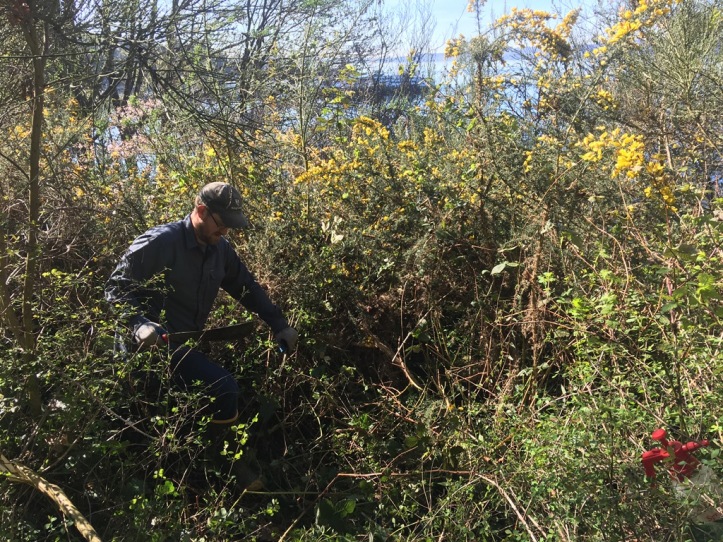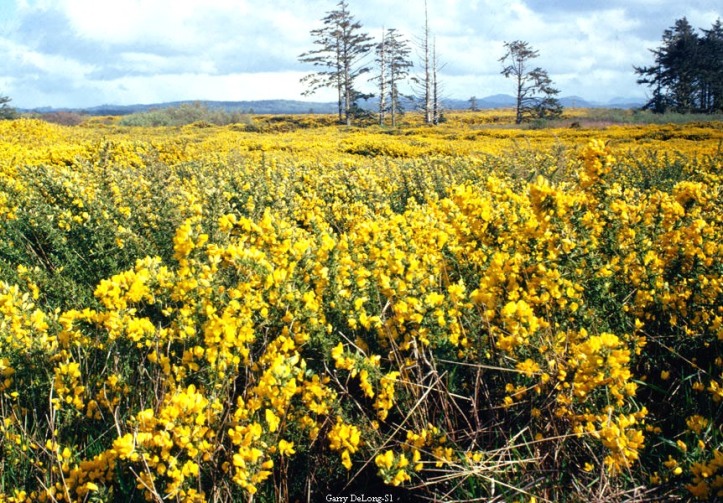Gorse is one of the earliest and most conspicuous noxious weeds to flower in King County, adding a little color to the otherwise dull-looking hillsides. Unfortunately, along with the attractive blooms comes a huge, thorny, invasive bush that is a fire hazard as well.

In years past, if you were on the ferry coming to West Seattle this time of year and noticed yellow-flowered bushes dotting the hillsides of Lincoln Park, you were probably looking at gorse. Although there is also Scotch broom scattered along that hillside, it usually doesn’t flower until late in March, whereas gorse starts blooming in February. This year we hope that you don’t see any flowering gorse on that hillside. After years of battling this infestation, Seattle Parks and King County Noxious Weeds have beaten it back to just a few plants.

King County noxious weed specialist Eric Walker hacks his way toward a large gorse plant on the hillside of Lincoln Park. Photo by Matt Below.
A year ago this month, a small band of King County weed specialists set out to do battle with the final remnants of gorse growing on the steep, sandy bluffs of Lincoln Park. After prospecting the best way in, they wielded machetes to cut their way through overgrown thickets of blackberry and ivy to get to the gorse stands. Some of the individual gorse trunks were several inches thick. They estimated there was about 600 square feet of gorse remaining, considerably reduced from when it was first noticed over fifteen years ago. Because of their work, we expect to see very little if any remaining this year.

As you may have heard, gorse has a fierce reputation, both in fiction and real life. In Winnie the Pooh’s story, when the balloon that’s carrying him is popped by angry bees, Pooh falls into a bush and gets covered with spines. That mean-looking bush was gorse. The same plant that in real life fueled a massive fire in the town of Bandon, Oregon in the 1930’s in which 14 people died and most of the town’s buildings burned down.

Gorse is a tall, densely growing shrub that looks like Scotch broom, but with thorns. Like Scotch broom, gorse invades open areas such as fields, shorelines and forest clearings, and crowds out other plants. The dangerous part about gorse is that it contains a volatile oil that can increase the risk of fire, especially when there are large stands of gorse like there were around Bandon. In addition, gorse can interfere with re-vegetation of forests and shoreline habitats and can suppress native wildflowers and forage plants.
Gorse, known scientifically as Ulex europeaus, does in fact originate from Europe as you might guess from the name. It was brought to the Pacific Northwest as an ornamental, likely due to its golden yellow blooms, which smell somewhat like cocoa butter, and its sturdy, easy-to-grow nature.

It spreads only by seed, but the seeds are extremely durable and long-lived, remaining viable for decades. Also gorse will re-sprout from the crown if it is cut down and is very hard to control by any means.

Although it wasn’t planted as widely as Scotch broom, gorse has spread extensively along the Pacific Coast from Canada to California and even two Hawaiian islands. It also occurs in the northeastern United States. In King County, we only have occasional populations of gorse and we are getting the upper hand on all the areas we know about. However, the plants are tough and the seeds are long-lived, so we continue to see new plants show up and old ones re-grow.

Early detection followed by effective control is very important in order to keep gorse from spreading to new areas and to reduce the risk of fire. You can read more about gorse on our web page or visit the Washington State Weed Board’s website. If you have any concerns about gorse or spot any new infestations, please contact the noxious weed program or report the location online.


